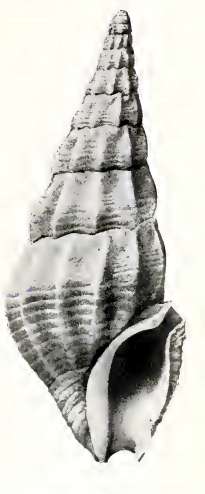Drillia aerope
Drillia aerope is a species of sea snail, a marine gastropod mollusk in the family Drilliidae.[2]
| Drillia aerope | |
|---|---|
 | |
| Original image of a shell of Drillia aerope | |
| Scientific classification | |
| Kingdom: | Animalia |
| Phylum: | Mollusca |
| Class: | Gastropoda |
| Clade: | Caenogastropoda |
| Clade: | Hypsogastropoda |
| Clade: | Neogastropoda |
| Superfamily: | Conoidea |
| Family: | Drilliidae |
| Genus: | Drillia |
| Species: | D. aerope |
| Binomial name | |
| Drillia aerope (W.H. Dall, 1919) [1] | |
| Synonyms[2] | |
| |
Description
The shell grows to a length of 16 mm.
(Original description) The small, acute shell is whitish. It has a polished, smooth, trochiform protoconch of about 2½ whorls. The teleoconch contains the subsequent eight or more whorls. The suture is distinct and slightly appressed. The anal fasciole is slightly constricted. The spiral sculpture consists of sharp narrow grooves, with much wider flat smooth interspaces. There are about eleven of the grooves on the body whorl between the shoulder and the spirally threaded siphonal fasciole. The anal fasciole is not spirally striate. The axial sculpture consists of (on the body whorl about 10) sharp-edged ribs, with wider interspaces, compressed and arcuate on the anal fasciole, nearly vertical elsewhere and extending over the whole whorl, but not continuous over the spire. The incremental lines are inconspicuous. The aperture is rather wide and short with a deep rounded anal sulcus and a prominent subsutural callosity. The outer lip is subvaricose, sharp-edged and smooth within. The inner lip shows a thick layer of enamel. Its outer edge is raised with a slight chink between it and the siphonal fasciole. The columella is short and straight. The siphonal canal is deep, short, wide, and slightly recurved.[3]
Distribution
This species occurs off Agua Verde Bay, Gulf of California, Western Mexico
References
- Dall, W.H. (1919a) Descriptions of new species of mollusks of the family Turritidae from the west coast of America and adjacent regions. Proceedings of the United States National Museum, 56, 1–86, 24 pls
- Drillia aerope (Dall, 1919). Retrieved through: World Register of Marine Species on 8 October 2011.
- Dall (1919) Descriptions of new species of Mollusca from the North Pacific Ocean; Proceedings of the U.S. National Museum, vol. 56 (1920) (described as Elaeocyma aerope)
- Angeline Myra Keen (1971). Sea Shells of Tropical West America: Marine Mollusks from Baja California to Peru. Stanford University Press. p. 701. ISBN 978-0-8047-0736-7.
- Tucker, J.K. 2004 Catalog of recent and fossil turrids (Mollusca: Gastropoda). Zootaxa 682:1–1295
External links
- "Drillia aerope". Gastropods.com. Retrieved 16 January 2019.